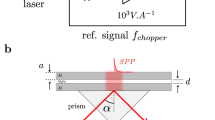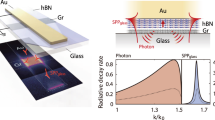Abstract
Direct rectification of electromagnetic radiation is a well-established method for wireless power conversion in the microwave region of the spectrum, for which conversion efficiencies in excess of 84% have been demonstrated1,2,3,4,5,6. Scaling to the infrared or optical part of the spectrum requires ultrafast rectification7,8,9,10 that can only be obtained by direct tunnelling11,12. Many research groups have looked to plasmonics to overcome antenna-scaling limits and to increase the confinement10,13,14,15,16,17,18,19,20,21. Recently, surface plasmons on heavily doped Si surfaces were investigated as a way of extending surface-mode confinement to the thermal infrared region22. Here we combine a nanostructured metallic surface with a heavily doped Si infrared-reflective ground plane designed to confine infrared radiation in an active electronic direct-conversion device. The interplay of strong infrared photon–phonon coupling and electromagnetic confinement in nanoscale devices is demonstrated to have a large impact on ultrafast electronic tunnelling in metal–oxide–semiconductor (MOS) structures. Infrared dispersion of SiO2 near a longitudinal optical (LO) phonon mode gives large transverse-field confinement in a nanometre-scale oxide-tunnel gap as the wavelength-dependent permittivity changes from 1 to 0, which leads to enhanced electromagnetic fields at material interfaces and a rectified displacement current that provides a direct conversion of infrared radiation into electric current. The spectral and electrical signatures of the nanoantenna-coupled tunnel diodes are examined under broadband blackbody and quantum-cascade laser (QCL) illumination. In the region near the LO phonon resonance, we obtained a measured photoresponsivity of 2.7 mA W–1 cm–2 at −0.1 V.
This is a preview of subscription content, access via your institution
Access options
Subscribe to this journal
Receive 12 print issues and online access
$259.00 per year
only $21.58 per issue
Buy this article
- Purchase on Springer Link
- Instant access to full article PDF
Prices may be subject to local taxes which are calculated during checkout





Similar content being viewed by others
References
Brown, W. C. An experimental low power density rectenna. IEEE Int. Microw. Symp. Digest 1, 197–200 (1991).
Green, S. I. Point contact MOM tunneling detector analysis. J. Appl. Phys. 42, 1166–1169 (1971).
Green, M. A. & Shewchun, J. Current multiplication in metal–insulator–semiconductor (MIS) tunnel diodes. Solid-State Electron. 17, 349–365 (1974).
McSpadden, J. O., Fan, L. & Chang, K. Design and experiments of a high-conversion-efficiency 5.8-Ghz rectenna. IEEE Trans. Microw. Theory 46, 2053–2060 (1998).
Kwok, S. P. Metal–oxide–metal (M-O-M) detector. J. Appl. Phys. 42, 554–563 (1971).
Suh, Y.-H. & Chang, K. A high-efficiency dual-frequency rectenna for 2.45-and 5.8-GHz wireless power transmission. IEEE Trans. Microw. Theory 50, 1784–1789 (2002).
Byrnes, S. J., Blanchard, R. & Capasso, F. Harvesting renewable energy from earth's mid-infrared emissions. Proc. Natl Acad. Sci. USA 111, 3927–3932 (2014).
Biagioni, P., Huang, J. S. & Hecht, B. Nanoantennas for visible and infrared radiation. Rep. Prog. Phys. 75, 024402 (2012).
Ward, D. R., Hüser, F., Pauly, F., Cuevas, J. C. & Natelson, D. Optical rectification and field enhancement in a plasmonic nanogap. Nature Nanotech. 5, 732–736 (2010).
Grover, S., Dmitriyeva, O., Estes, M. J. & Moddel, G. Traveling-wave metal/insulator/metal diodes for improved infrared bandwidth and efficiency of antenna-coupled rectifiers. IEEE Trans. Nanotech. 9, 716–722 (2010).
Sanchez, A., Singh, S. K. & Javan, A. Generation of infrared radiation in a metal-to-metal point-contact diode at synthesized frequencies of incident fields: a high-speed broad-band light modulator. Appl. Phys. Lett. 21, 240 (1972).
Sanchez, A., Davis, C. F., Liu, K. C. & Javan, A. The MOM tunneling diode: theoretical estimate of its performance at microwave and infrared frequencies. J. Appl. Phys. 49, 5270–5277 (1978).
Adams, D. C. et al. Funneling light through a subwavelength aperture with epsilon-near-zero materials. Phys. Rev. Lett. 107, 133901 (2011).
Alù, A., Silveirinha, M. G., Salandrino, A. & Engheta, N. Epsilon-near-zero metamaterials and electromagnetic sources: tailoring the radiation phase pattern. Phys. Rev. B 75, 155410 (2007).
Edwards, B., Alù, A., Young, M. E., Silveirinha, M. & Engheta, N. Experimental verification of epsilon-near-zero metamaterial coupling and energy squeezing using a microwave waveguide. Phys. Rev. Lett. 100, 033903 (2008).
Liu, X., Starr, T., Starr, A. F. & Padilla, W. J. Infrared spatial and frequency selective metamaterial with near-unity absorbance. Phys. Rev. Lett. 104, 207403 (2010).
Wang, F. & Melosh, N. A. Plasmonic energy collection through hot carrier extraction. Nano Lett. 5426–5430 (2011).
Kekatpure, R. D. & Davids, P. S. Channeling light into quantum-scale gaps. Phys. Rev. B 83, 075408 (2011).
Pendry, J. B., Moreno, L. M. & Garcia-Vidal, F. J. Mimicking surface plasmons with structured surfaces. Science 305, 847–848 (2004).
Garcia-Vidal, F. J., Moreno, L. M. & Pendry, J. B. Surfaces with holes in them: new plasmonic metamaterials. J. Opt. A 7, S97–S101 (2005).
Davids, P. S., Intravaia, F. & Dalvit, D. A. R. Spoof polariton enhanced modal density of states in planar nanostructured metallic cavities. Opt. Exp. 22, 12424–12437 (2014).
Ginn, J. C., Jarecki, R. L., Shaner, E. A. & Davids, P. S. Infrared plasmons on heavily-doped silicon. J. Appl. Phys. 110, 043110 (2011).
Lehmann, A., Schumann, L. & Hübner, K. Optical phonons in amorphous silicon oxides. I. Calculation of the density of states and interpretation of LO TO splittings of amorphous SiO2 . Phys. Stat. Sol. B 117, 689–698 (1983).
Sze, S. M. & Ng, K. K. Physics of Semiconductor Devices (Wiley, 2006).
Schenk, A. & Heiser, G. Modeling and simulation of tunneling through ultra-thin gate dielectrics. J. Appl. Phys. 81, 7900–7908 (1997).
Jauho, A. P., Wingreen, N. S. & Meir, Y. Time-dependent transport in interacting and noninteracting resonant-tunneling systems. Phys. Rev. B 50, 5528–5544 (1994).
Shah, J. Hot Carriers in Semiconductor Nanostructures: Physics and Applications (Elsevier, 1992).
Landauer, R. & Martin, T. Barrier interaction time in tunneling. Rev. Mod. Phys. 66, 217 (1994).
Cardona, M. & Peter, Y. Y. Fundamentals of Semiconductors (Springer, 2005).
Maraghechi, P., Foroughi-Abari, A., Cadien, K. & Elezzabi, A. Y. Enhanced rectifying response from metal–insulator–insulator–metal junctions. Appl. Phys. Lett. 99, 253503 (2011).
Acknowledgements
P.S.D. thanks P. Rakich from Yale University and W. Burckel and R. Sanchez from Sandia for many useful and enlightening discussions. Funding for this work was provided by Sandia's Laboratory Directed Research and Development program and the US Department of Defense. Sandia is a multiprogramme laboratory operated by Sandia Corporation, a Lockheed Martin Company, for the US Department of Energy's National Nuclear Security Administration under contract DE-AC04-94AL85000.
Author information
Authors and Affiliations
Contributions
P.S.D. conceived and led the project. D.W.P., D.B.B. and P.S.D. designed and simulated the antenna. R.L.J. and A.S. developed the fabrication process and fabricated the devices. E.A.K., T.R., E.A.S. and P.S.D. performed the infrared experimental characterization of the devices.
Corresponding author
Ethics declarations
Competing interests
The authors declare no competing financial interests.
Supplementary information
Supplementary information
Supplementary information (PDF 2101 kb)
Rights and permissions
About this article
Cite this article
Davids, P., Jarecki, R., Starbuck, A. et al. Infrared rectification in a nanoantenna-coupled metal-oxide-semiconductor tunnel diode. Nature Nanotech 10, 1033–1038 (2015). https://doi.org/10.1038/nnano.2015.216
Received:
Accepted:
Published:
Issue Date:
DOI: https://doi.org/10.1038/nnano.2015.216
This article is cited by
-
Millimeter-wave to near-terahertz sensors based on reversible insulator-to-metal transition in VO2
Communications Materials (2023)
-
MOF/Polymer-Integrated Multi-Hotspot Mid-Infrared Nanoantennas for Sensitive Detection of CO2 Gas
Nano-Micro Letters (2022)
-
Tunnel field-effect transistors for sensitive terahertz detection
Nature Communications (2021)
-
Terahertz rectification in ring-shaped quantum barriers
Nature Communications (2018)
-
Coherent tunneling in an AlGaN/AlN/GaN heterojunction captured through an analogy with a MOS contact
Scientific Reports (2017)



